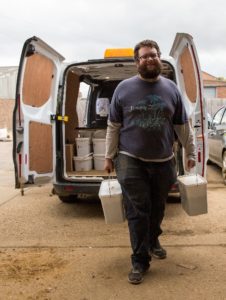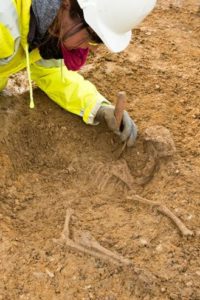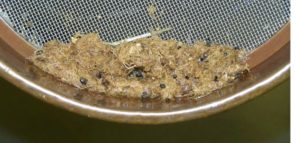Have you ever wondered what happens behind the scenes in archaeology? There’s a lot more to it than digging: environmental sampling, finds recording and analysis, osteological research (on human bones) and interpreting the findings for the public – to name just a few.
We have been catching up with a few of the specialists bringing their archaeological skills to the A14 Cambridge to Huntingdon improvement scheme, based at the MOLA Headland Infrastructure processing base in St Neots. Today we meet Environmental Supervisor Dave Taylor, who has been managing the processing of 4,000 soil samples from the 12,027 taken so far on the project.

What is your role and previous archaeological experience?
I have been an Environmental Supervisor with MOLA Headland Infrastructure since summer 2017, when the environmental processing for the A14 C2H archaeological excavations began.
My degree in archaeology and masters in geoarchaeology led me to supervising small teams on archaeological fieldwork projects. I did a short spell with the Police service so this job is quite a contrast.
What does a typical day involve?
![2 [small]](https://molaheadland.com/app/uploads/2018/03/2-small-215x300.jpg)
I supervise a small team in charge of processing the environmental samples taken on excavation sites, so I make sure they have all the training and equipment they need.
We carefully check the labels on the buckets coming from sites, logging in every sample to make a record for later. This ensures that we know where every piece of processed material comes from and how it fits into the site’s story, once analysed.
At the processing stage, a soil sample is placed into a specially designed environmental flotation tank. During flotation the lighter charred remains float to the surface and are collected in a sieve as the water flows out of the tank through a spout.
The heavier archaeological material sinks and is collected in a mesh inside the tank.

How are these fragments recovered?
The flot (light stuff) is collected in sieves and examined by archaeobotanists under a microscope in the lab. The retent (heavy stuff) is sorted through separately to look for small objects like beads or tiny animal bones.
How do you know what to sample?
Environmental Specialist Angela Walker, works to an agreed plan that follows Historic England guidelines and she consults with archaeologists during the excavations to fine tune the strategy.
She has to consider the value and potential of detailed environmental data to bring together a complete story of the site, alongside the analysis of artefacts and other archaeological material.
How does environmental analysis help us to learn more about past populations in this part of Cambridgeshire?
Animal bones are often found on site, giving us information about what foods were commonly eaten and which animals were kept.
Tiny snail shells reveal ecological information, for example the dampness or type of landscape that they lived in. Cereal remains indicate what crops were being grown and weed seeds can show how ecological conditions varied over the centuries.
And fruit stones or pips tell us about people’s diets through history.
Bringing together all of this information provides an overall picture of the development and use of the Cambridgeshire landscape over several millennia.
 What is the most interesting item you have found?
What is the most interesting item you have found?
Tiny pieces of environmental evidence are discovered through environmental processing, including tiny fish bones, pollen ‘micro-fossils’ and tiny beads.
These minute items are often illuminating. Frog bones tell us that the environment they came from was damp with standing water nearby. It’s great to think that from these fragments archaeologists can piece together a big picture about the wider landscape in the past.
How does this work fit into the whole project? 
Environmental Specialist and Archaeobotanist Angela Walker, analyses the material site by site and brings it together with the research done by other specialists, such as for animal bone, insects, pollen and shells specialists.
Together this environmental evidence paints a picture of the A14 C2H landscape in the past and how humans manipulated it.
Join us on our journey
- @A14C2H #A14Archaeology
- facebook.com/A14C2H/ #A14Archaeology
- Come to one of our community archaeology events
- Find out more about the A14C2H improvement scheme here
The archaeological programme for the Cambridge to Huntingdon improvement scheme is being carried out for A14 Integrated Delivery Team on behalf of Highways England.